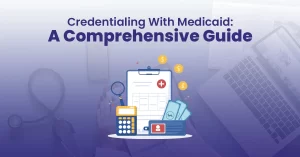Medical groups, hospitals, and healthcare organizations are dealing with rising costs, and decreasing reimbursements. These organizations are looking for ways to cut costs, increase revenue, and speed up their payor enrollment credentialing for more timely reimbursement.
The terms “payor enrollment” and “payor credentialing” are often used interchangeably in healthcare industry. Enrolling payors and verifying their credentials is complicated, and it gets tougher with each passing year.
Your cash flow will suffer due to improper enrollments and credentialing so the revenue cycle management platform will not function properly. Payor credentialing services involves verification of a healthcare provider’s qualifications for inclusion in a network of doctors. Hospitals and health systems also do medical credentialing to ensure that a clinician’s training, certifications, and professional experience are up to date.
How to Accelerate Payor Credentialing?
Payor enrollment goals align with revenue integrity priorities, such as coding, charge capture, financial projections, optimized payments, and spending as little time as possible fixing avoidable claim errors. If you keep the following points in mind, the credentialing process will go much faster:
Automated Payor Transactions
The process of credentialing and enrolling a new provider can be time consuming. Automation technology, has the potential to make this process more efficient for you and your staff. Each provider is required to submit a variety of forms. There are several tools available to help you automate the form completion process associated with enrolling in a new provider. In provider credentialing, verifying the information provided by the providers takes time as well. This task is made more efficient by automation technology. The majority of your provider credentialing process can undoubtedly be speed up with automated data verification.
Contracts with Payors
Managing payor contracts is one of the primary challenges that every healthcare provider faces. Payer contracts describe a provider’s reimbursement arrangement for providing healthcare services to patients covered by a particular health plan. Understanding complex payer contracts is essential for ensuring accurate and timely reimbursement. Payer contracts include fee schedules, reimbursement criteria, and terms for timely reimbursement.
Centralized Provider Data
Inaccurate or incomplete information about a provider’s professional certifications, work history, or malpractice insurance causes lengthy credentialing and enrollment delays, resulting in member access issues and revenue loss. After providers have been enrolled, they must keep their information up-to-date regularly. Within 90 days, all other changes must be reported.
Using a centralized source of verification that is consistently reconciled and dynamically validated against primary sources is helpful to maintain clean, accurate provider data. The centralization of real-time provider data improves data quality, accessibility, and transparency and reduces provider frustration by eliminating duplicative requests for information.
Quality Review
The entire payor enrollment process is mapped internally for quality review. It’s critical to map the provider enrollment process from the recruiting stage to final payor approval. It’s critical to hold the payor accountable for what they promised in the signed contract from the outside. Consider the following inquiries:
Is the process completed within the allotted time?
Are the payor directories up to date and easy to find?
Is the payor providing the level of service that is expected?
The details of how the payors will be held accountable for their errors and failures must be included in your plan of correction.
Although the enormity of incorporating the payor enrollment team into the revenue integrity department cannot be fully summarized in five steps, these best practices can help ensure that all reimbursements associated with payor enrollments are collectible.
If you’re looking for a way to speed up the provider credentialing process in 2022, outsourcing your payor enrollment credentialing is one of the best options. Credentialing services providers are experts at navigating this process, so they save time by ensuring everything is done the first time correctly.
Keep in mind that any delays in the credentialing process can hurt your practice’s bottom line. As long as a provider is uncredentialed, they are merely a cost to the practice rather than a source of revenue. While the process can be lengthy and tedious, there are ways to shorten it by mitigating delays.
Begin the process early, double-check that you have all the necessary data, avoid common mistakes, and keep track of the process with payors. Consider outsourcing your payor enrollment credentialing to save time and money.
Streamlining Payor Enrollment:
Payor enrollment credentialing is a time-consuming process that can take months to complete. Payors typically take 90 to 120 days to complete provider credentialing alone, taking months on average to complete the entire payor credentialing process. Provider enrollment may take even longer for smaller plans with limited resources. Healthcare organizations aggravate the situation by failing to collect all required documents for credentialing and making multiple attempts to complete payor enrollment. As a result, when workflow inefficiencies add time to an already lengthy process, organizations are likely to experience delays in claims reimbursement.
Why Do You Need a Reliable Credentialing and Enrollment Process for Your Providers?
Bellmedex is here to ensure that your office gets its credentials promptly and accurately so that you can start receiving reimbursement immediately. We have the experience and knowledge to help you get through the process with the least amount of stress possible. All your office needs to do is provide us with the necessary information and documents, and then we’ll take care of the rest!
By reviewing and gathering documentation to determine the provider’s participation in the health plan, the best healthcare revenue cycle management partner helps you simplify the payor credentialing and enrollment process. The headaches of submitting and tracking payor enrollment credentialing applications based on insurance plan requirements are eliminated with a dependable and efficient enrollment credentialing system.




